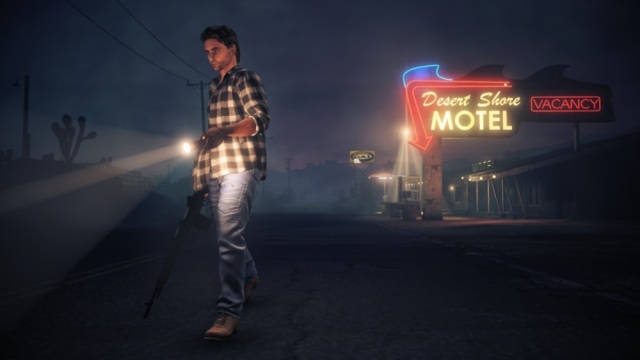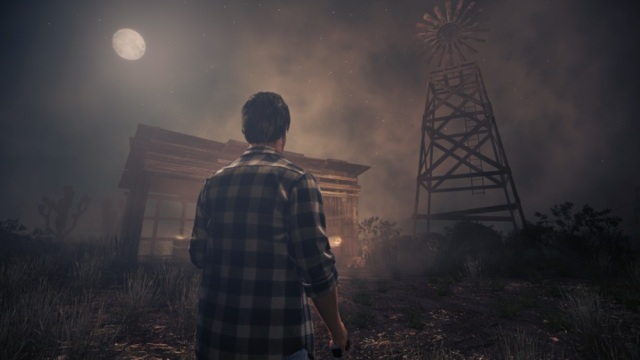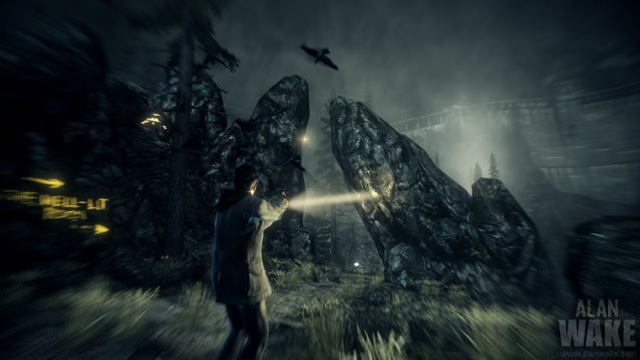In case you’ve been living under a rock for a while, you’ll know that this week sees the release of the downloadable only Alan Wake’s American Nightmare, the follow up to the original – disc based – Alan Wake. In the run up to the release, we got a chance to sit down and talk with Remedy’s head of franchise development, Oskari Hakkinen.
So, Alan Wake is coming to PC and Alan Wake’s American Nightmare is coming to the Xbox LIVE Arcade. Can you give us the exact release dates?
Oskari Hakkinen: Alan Wake’s American Nightmare is coming out on the 22nd of February and Alan Wake for PC is being released on the 16th of February [on Steam], with retail on March 2nd. The studio is really busy at the moment, we are working on projects that I can’t talk about right now. Triple A is still very close to our hearts, but we are doing these smaller projects that are quite fresh as well. American Nightmare we did in house, that was about eight months of development, and the PC version we are working with a third party partner but there are a few guys from [Remedy’s] tech team who are making sure justice is done to the PC version.
What can PC gamers expect from the Alan Wake PC release? Is all the Xbox 360 DLC going to be included?
Every PC version we are putting out is including the DLCs as well. On Steam there is a Standard Edition and Limited Collectors Edition. Standard Edition is the game and the DLCs, whereas the Limited Edition also includes developer commentary, cinematic score and the Alan Wake Files book in PDF form. For the retail release there is a Standard Edition which a little bit better than standard; it’s got a sticker set, a double sided poster, five postcards and the cinematic score included. The retail Limited Edition has all of the above plus the developers diaries, developer commentary, some special trailers and the Alan Wake Files book – a physical book – in it as well. Pretty cool packages. For PC gamers out there, they should expect higher fidelity, higher resolutions across the board. Remedy are PC gamers at heart. I’m thinking of Death Rally, Max Payne one and two. It is in Remedy’s heritage to do PC games and we want to do this right. A lot of effort has gone into getting it right on all fronts; how the controls work with the mouse and the keyboard, a lot of effort has gone into making that feel right. With the third person camera, players can adjust their field of view, there’s lots and lots of different graphical configurations for whatever set up you might have. There’s also new features like ‘Hide HUD’ which was a sought after feature with the Xbox; people wanted to remove the clutter off the screen because the game had quite an immersive feeling. We are supporting some features like stereoscopic 3D as well.

Wow, OK, so the PC version of Alan Wake is the definitive version?
You know, for those players who really want to play with all the settings maxed out then the PC version is probably the way to go. When you look at the PC version it looks absolutely phenomenal.
Let’s talk American Nightmare. Does it follow that same episode structure that the first Alan Wake did or is it a standalone episode?
It is a standalone spinoff experience. It is an episode, but it is not an episode in the same way that the player experienced in Alan Wake. Alan Wake was a season, a DVD box set, if you like. American Nightmare is an episode of Night Springs. Now, Night Springs is from Alan Wake, the TV show that had this Twilight Zone-esque feel, and the backstory goes that early on in Wake’s career he had written a couple of episodes of Night Springs. Now, in American Nightmare, you are playing an episode of Night Springs and it is written by Alan Wake himself. Wake has learnt a lot since we saw him last and he is able to use fiction to his advantage and that is what he is doing in American Nightmare. Wake is using fiction that he has written before as a channel to defeat (or fight) against Mr Scratch, who appeared after the events of the first game. In Bright Falls, after the dust had settled, Wake had gone missing, Barry and Alice had left and the locals had started to talk about the events of Alan Wake and described them as ‘this rockstar writer who came to their small town and brutally murdered his wife in a cabin’. We know that didn’t happen. However, that’s the urban legend that is told, over and over again, and Mr Scratch is born because we know that in Bright Falls there is an energy that can make fiction become real. Scratch is a supernatural serial killer on his way to do horrible things to Wake’s wife Alice, and Wake is finding a channel to be able to stop him and that channel is Night Springs. Night Springs is, as I said, the Twilight Zone-esque type show from the first game so everything here is, of course, like in the Twightlight Zone; wilder. Wilder new enemies and wilder new weapons. It is standalone, so anyone can jump on board, but for the fans out there, there is a huge amount of optional story content that does expand the universe.

Alan Wake was known for being inspired Stephen King, David Lynch, Twin Peaks, that sort of thing so, aside from the Twilight Zone, what other inspirations have been brought into the mix?
Twilight Zone would be for the packaging, because this is an episode of Night Springs and Night Springs was inspired by The Twilight Zone. The inspirations for American Nightmare are a lot of grindhouse, classic Americana, B-movie classics, classic sci-fi, From Dusk Till Dawn, Quentin Tarantino. The story is very pulp fiction, as opposed to Stephen King and David Lynch. The setting is different, you’re in Arizona, you’ve got the drive-in theatre, roadside motels, mountaintop observatory with a secret message from the stars. All very B-movie inspired.
When Alan Wake was being made and split into episodes, was the plan always to do different things with different episodes, changing setting and tone, whilst still staying within the Wake universe, or was this opportunity spotted after the fact?
Yeah, it was something we realised after the fact. The way the episodic structure got its inception was Sam Lake [Writer of Alan Wake, current Remedy Creative Director] was looking for a better way to tell stories in video games. With Max [Payne], we used a movie structure, where you have your start and your end and you have three acts. By Max Payne 2, Sam was already saying that there must be a better way to tell stories in videogames. The three act structure left the story very diluted, it works great for a movie, one and a half hours or two hours, but for ten or fifteen hours it doesn’t work. How do you keep somebody engaged for that whole time? It was about that time that Sam was becoming quite enthusiastic about Lost and he was like ‘This is it, this is how it needs to be told. It needs to be broken down into episodes’. The idea was that each episode could have its own three acts, and if an episode lasts for about one and a half hours, how fantastic, perfect, it has its own arc and structure and each episode is then very intense and you can deliver a roller coaster ride.
Seeding things in one episode that can feed into others…
Yes. Sam really found that was the best way to tell stories in videogames and we will continue to do that.

What sort of length should people expect from Alan Wake American Nightmare?
There’s a Story Mode and an arcade action Mode. The story mode is a pulp action adventure, it’s more focussed on action than on story, but that’s because it is made for the medium. It is made for the Xbox LIVE Arcade, and in general people that play XBLA games are expecting a little bit easier story and easier game to jump on board with and just start enjoying themselves. It is made with that in mind. The story mode is about five hours long and in addition to that is the arcade action mode that we call Fight Till Dawn. Fight Till Dawn has five maps and is just hours and hours of endless fun. The idea there is to find out who is the real Champion of Light so we have online leaderboards and scoreboards. Once the player has beaten all five maps you have survived until dawn and unlock Nightmare Mode which is, of course, less ammunition and much faster waves of enemies and a lot harder.
Apart from the new modes, any big gameplay tweaks that players should know about?
The core combat mechanics have been improved, they have been kept the same, but they are improved and taken forward. You have better visualisation of when the enemies have their shadow shields, for example. Bullets ricochet off and you can see when they are holding that dark presence. In terms of variation, we have looked at the game from a weapon point of view and an enemy point of view. We have new enemies like the Splitter, for instance, that turns the tables on you. If you use your flashlight on the splitter he will split and duplicate so, if you didn’t mean to do it, it’s really heart pumping. You’ve also got the grenadier who keeps his distance. Before in Alan Wake, all the enemies would attack you directly, but now the grenadier keeps his distance and throws grenades so you need to hunt him down. The Birdman is unique because if you use your flashlight on him he dissipates into a flock of birds, flying around and looking for a perfect spot to come and attack you from behind.
On the weapon side there is a lot of variation, for instance the crossbow. The crossbow is a weapon that can pierce the darkness without requiring the use of the flashlight. That makes it sound like a super weapon, but it’s not because it takes a long while to reload. So in some ways the perfect weapon, but it has its weaknesses.
We are offering a lot of variation through those things, playing with light and darkness yet again.

Alan Wake had a very unique atmosphere. Are you worried at all, that with the change of setting with American Nightmare that the game will lose its unique feel?
I think it will have a bit less atmosphere because, as I said, it is made for the medium and we understand that different games are made for different situations, whether that be playing a smartphone game on the bus or whether you are at home and just want a quick blast of game gratification. On XBLA you have got great games like Super Meat Boy and Limbo. American Nightmare is made with that in mind, that it’s very pick up and play, easy to jump on board and it is more action orientated because of that. There is less of a thriller feeling, but that comes from the change of influences as well; it’s less Stephen King, less David Lynch and more this grindhouse and B-movie stuff. There is also a different approach to level design. It is a hub level approach, so you are revisiting some key locations, but you are experiencing them in a different flow. On XBLA there are some limitations on file size so we have had to kind of find a smart way to bring out a visually beautiful game, the tech has moved forward from Alan Wake, so a visually beautiful game with a decent story within the XBLA file size limitations.
That all being said, what prompted the choice of making this an XBLA title? Why this instead of Alan Wake 2 in a couple of years or so?
That’s a good question. The inception of Alan Wake’s American Nightmare actually started, believe it or not, from the arcade action. A lot of people might think ‘Arcade action, that’s not really Remedy, what are you doing?’ What we were doing was looking at the reception for Alan Wake. People were saying that they would have liked a little bit more action, a little bit more variation with enemies and weapons, and that is what we did. We white-boxed out levels and made the designers throw in all of their wild enemies and weapons, make the levels really out there and we will see what we can use and what we can’t use in the future. They did that and it turned out to be really fun, everyone in the office was playing it. Then a whiteboard got set up where everyone wrote their best score and somebody says out loud that this would be a perfect fit for XBLA, which it would be. However, story is in our DNA and this is Alan Wake, which is a very important franchise to us, so Sam Lake goes away and thinks about how this can work and decides to use Night Springs as a channel to introduce all the crazy shit that is going on. A story mode was added, and we went with a more pulp action adventure as opposed to a psychological action thriller. That’s how it came about.

So it seems a lot of Alan Wake’s American Nightmare was born out of playing around and experimenting in the office, rather than a hard and fast plan?
It very much was. People are asking us for more escalation and crazier enemies and we really felt that we couldn’t do that for Alan Wake, we couldn’t put more weirder weapons in. It would have taken you out of the immersion of the experience if, all of a sudden, he had an AK-47. He is a writer, he’s not a commando, he’s not a space marine, he’s just a regular guy and we wanted it to be very grounded in reality. But we understand that people want these fun things, people like the core combat mechanics and they wanted it to go a little bit wilder and people wanted more of the fun factor. The fun factor is in American Nightmare but it is part of the universe of Alan Wake, it is very carefully thought out franchise and, again, Night Springs as a setting makes all this sillyness make sense.
It says a lot for the universe that you can grab small pieces of it, like Night Springs, blow them up and they still be interesting places to visit and experience.
It didn’t come entirely by accident that we used Night Springs. Sam had a pre-existing idea for Night Springs, but nothing is ever written in stone. When the core idea for American Nightmare came about he mapped his idea on to that.
Alan Wake’s American Nightmare scored 7/10 in the GodisaGeek Review. Alan Wake for PC will be available to buy in stores on March 2nd, courtesy of Nordic Games.





